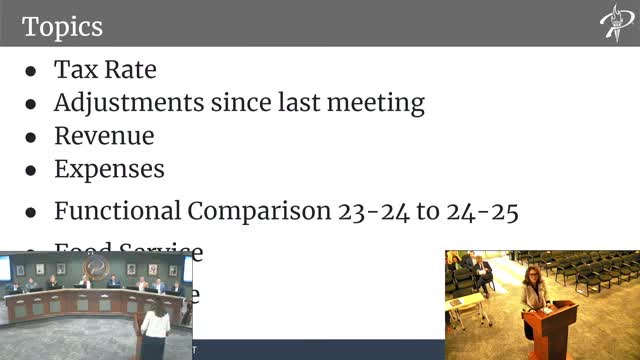Budget Crisis Looms as Schools Face $15 Million Deficit
August 27, 2024 | PROSPER ISD, School Districts, Texas
This article was created by AI summarizing key points discussed. AI makes mistakes, so for full details and context, please refer to the video of the full meeting. Please report any errors so we can fix them. Report an error »

In a recent government meeting, officials discussed critical budgetary adjustments and the implications of tax rates for the upcoming fiscal year. The meeting focused on the school district's financial outlook, including a review of revenues, expenses, and the impact of student enrollment growth.
The district's tax rate remains unchanged from July, with a proposed rate of 1.2552, reflecting an 8.33% increase over the calculated no-new-revenue rate of 1.158570. This decision is significant as adopting the no-new-revenue rate could lead to a substantial loss in combined state and local revenue, which is crucial for funding educational programs.
Officials anticipate an increase of approximately 2,500 students in average daily attendance, contributing to a projected revenue growth from $48.9 million to $51 million. This increase is attributed to the district's fast growth allotment, which has risen by $4 million from the previous year, although it remains prorated and not guaranteed.
The budget proposal for the 2024-2025 fiscal year includes a total of $362.7 million, with a notable focus on staffing costs, which account for 81.1% of the budget. The district has added around 565 new positions, reflecting a commitment to enhancing educational quality despite facing a projected $15 million deficit. This deficit is partly due to salary increases for teachers, a decision praised by board members as essential for attracting and retaining quality educators.
The meeting also highlighted the challenges posed by inflation and rising operational costs, particularly in areas such as utilities and custodial services. The district is taking steps to manage these expenses while ensuring that instructional costs remain a priority.
As the legislative session approaches, officials emphasized the need for continued support for public education, engaging with state representatives to advocate for necessary funding and resources. The discussions underscored the district's commitment to maintaining educational standards while navigating financial constraints.
The district's tax rate remains unchanged from July, with a proposed rate of 1.2552, reflecting an 8.33% increase over the calculated no-new-revenue rate of 1.158570. This decision is significant as adopting the no-new-revenue rate could lead to a substantial loss in combined state and local revenue, which is crucial for funding educational programs.
Officials anticipate an increase of approximately 2,500 students in average daily attendance, contributing to a projected revenue growth from $48.9 million to $51 million. This increase is attributed to the district's fast growth allotment, which has risen by $4 million from the previous year, although it remains prorated and not guaranteed.
The budget proposal for the 2024-2025 fiscal year includes a total of $362.7 million, with a notable focus on staffing costs, which account for 81.1% of the budget. The district has added around 565 new positions, reflecting a commitment to enhancing educational quality despite facing a projected $15 million deficit. This deficit is partly due to salary increases for teachers, a decision praised by board members as essential for attracting and retaining quality educators.
The meeting also highlighted the challenges posed by inflation and rising operational costs, particularly in areas such as utilities and custodial services. The district is taking steps to manage these expenses while ensuring that instructional costs remain a priority.
As the legislative session approaches, officials emphasized the need for continued support for public education, engaging with state representatives to advocate for necessary funding and resources. The discussions underscored the district's commitment to maintaining educational standards while navigating financial constraints.
View full meeting
This article is based on a recent meeting—watch the full video and explore the complete transcript for deeper insights into the discussion.
View full meeting
